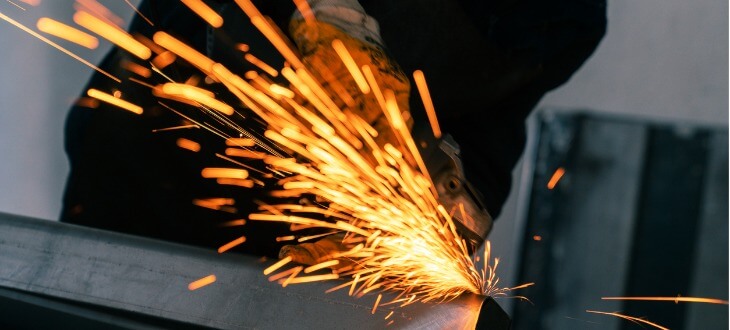A common question is, “How is aluminum welded?” Aluminum can be very tricky to weld, so you need to be careful when doing so. This article will outline how difficult it is to weld aluminum, how to weld it, what method to use, things to keep in mind while welding, and the benefits of welding aluminum.
How Difficult is it to Weld Aluminum?
Aluminum is hard to weld because it’s non-corrosive and lightweight, making it an ideal choice for a variety of welding projects. Additionally, the material is very soft, sensitive, and possesses an oxidized layer.
How to Weld Aluminum
There are many ways to weld aluminum. The best way includes:
- Ensure you remove any dirt, oil, dust, and so on from your aluminum and workstation
- Use a wire brush to remove the surface of the oxide
- Assemble the joint and cover it so there won’t be any dirt contaminating it
- Keep your aluminum dry and at room temperature
What Method Should I Use?
There are many different methods you can use to weld aluminum. For this article, we will focus on MIG and TIG welding.
MIG Welding
Metal Inert Gas (MIG) is a common method used to weld aluminum. MIG has faster travel speeds and higher deposition rates compared to other types of welding. MIG uses a mechanical wire feeding system, so you may have to use a spool gun or push-pull gun to make wire feeding.
TIG Welding
Tungsten Inert Gas (TIG) is a very popular welding process for aluminum. TIG requires constant current equipment with alternating current capabilities solely using argon gas. It does not require mechanical wire feeding.
What is the Trick to Welding Aluminum?
Prepare Your Station and Aluminum
Before you even start your project, you should prepare. Clean your workstation and ensure it is free from dirt, dust, grease, etc. You can use a microfiber cloth and some cleaning supplies to ensure it is ready.
Additionally, make sure that your aluminum is ready to go. You must clean it to ensure any debris is off your aluminum. This includes removing the oxide layer from your aluminum. It is recommended to use fleece to do so because using a brush may leave scratches on your aluminum. You will have to go through this process multiple times.
Select the Correct Welding Torch
As stated in the previous section, one can weld aluminum in many ways. With this in mind, you must pick the right welding torch to match the correct weld. The TIG process uses an altering current and is used for thinner sheets. The MIG process is used for thicker sheets with a higher melting rate. Plasma welding is a very challenging process but will allow you to work in a very targeted manner.
Choose Your Equipment Wisely
Each torch has specific equipment for welding. Before you begin welding, ensure you use the correct parts for each different process. Choose your equipment wisely and use it properly.
Use Transport Rolls
When using special transport rolls, it will have a U-groove that prevents your aluminum from deforming. Depending on the one you purchase, you may need to buy additional materials as needed.
Pick the Right Gas
You must pick the right gas for welding aluminum. Try argon or argon mixtures because they are used as protective gases. For thicker pieces of aluminum, try mixing argon and helium to get a higher temperature for your welding process. The proportion of helium will vary depending on the thickness of your aluminum.
Do Not Approach as a One-Size-Fits-All Solution
You should not treat this as a one-size-fits-all approach. You must take a different approach depending on the project. Do not base your experience on past metals or materials, as aluminum is a very different substance. If you do approach it as one-size-fits-all, you may be presented with dangers if handled incorrectly.
Wear the Proper Gear
When working with aluminum, it’s important to wear the proper personal protective equipment (PPE). Since welding aluminum can be dangerous, it’s important to educate yourself on the safety procedures and best practices.
Pay Special Attention to the Details
You may know by now that attention to detail is everything in welding. Try to pay attention to every detail and double-check your work. You do not want to make mistakes when welding aluminum.
Be Patient With the Process
Aluminum does not act like other elements — be patient and trust the process. Learning how to weld this material takes time.
The Benefits of Welding Aluminum
The many benefits of welding aluminum include the following:
- Aluminum is Lightweight: Compared to other materials, aluminum is lightweight. It also has a better strength-to-weight ratio, meaning it becomes stronger when the temperature decreases.
- Aluminum is a Great Conductor of Electricity and Heat: Aluminum is known to be an excellent conductor of electricity and heat. This means you need to be very careful when you are welding aluminum.
- Aluminum is Cost-Effective: Aluminum is very cost-effective because it is recyclable. This is one of the many reasons why aluminum is so popular.
- Aluminum is an Extremely Absorbent Material: Often chosen for its cosmetic qualities, aluminum absorbs paint and sealant.
Visit Tampa Steel & Supply for Quality Metal and Metal Processing Services
Do you need help with metalworking and keeping your metal fresh? The experienced professionals at Tampa Steel & Supply are here to help. We provide the highest quality of services to our customers.
Request a Quote Online
Or Call Tampa Steel & Supply at (813) 241-2801

